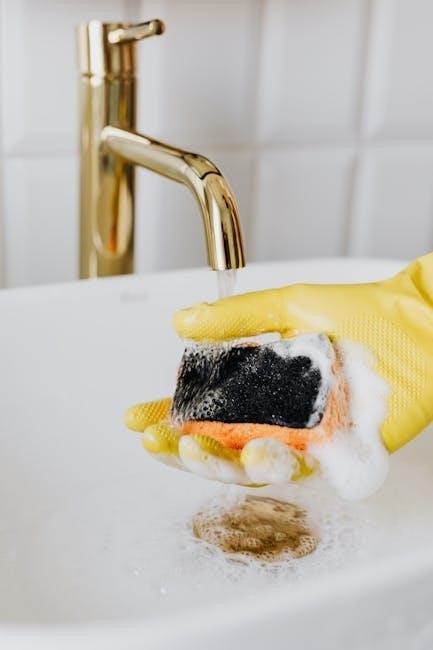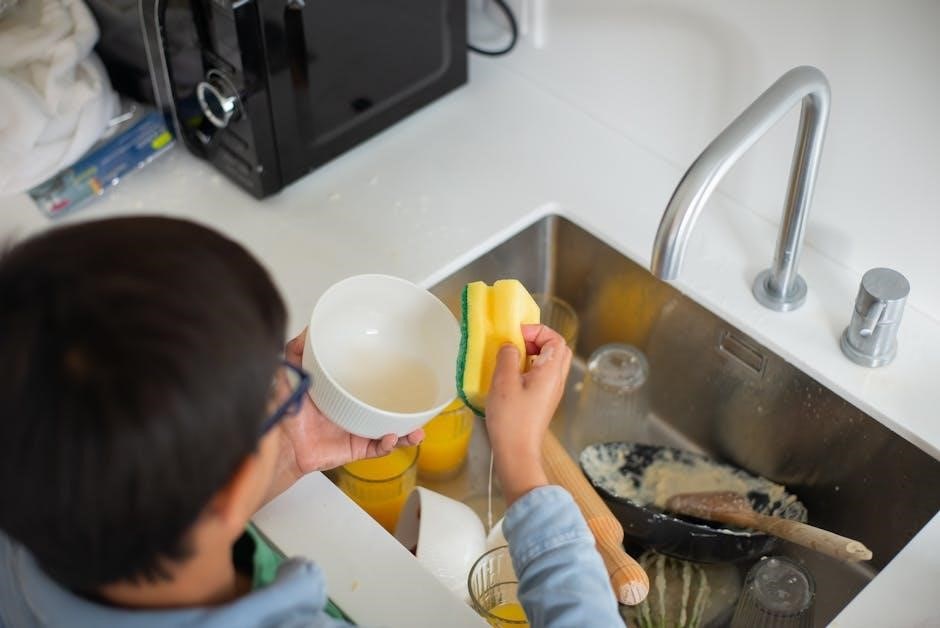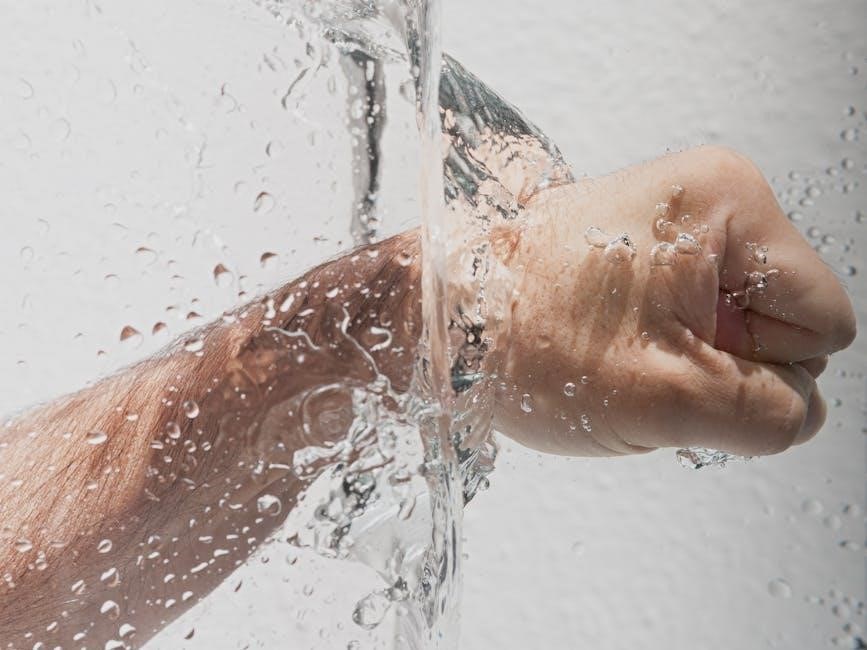
-
By:
- collin
- No comment
oeko-tex standard 100 washing instructions
OEKO-TEX Standard 100 is a global certification ensuring textiles are free from harmful substances, promoting safety and sustainability from production to finished product.
1.1 What is OEKO-TEX Standard 100?
OEKO-TEX Standard 100 is a certification by the OEKO-TEX Association, ensuring textiles are free from harmful substances. It applies to all textile types, testing for safety from yarn to finished product. The standard verifies the absence of 100 harmful chemicals, including those in buttons and zippers. Products are classified based on use, with testing parameters varying accordingly. Certification is renewed annually, ensuring ongoing compliance. This label is a trusted mark of safety and sustainability, benefiting both consumers and manufacturers globally.
1.2 Importance of OEKO-TEX Certification
OEKO-TEX certification ensures textiles meet rigorous safety and sustainability standards, protecting consumers from harmful substances. It builds trust by verifying products are free from 100+ hazardous chemicals. This certification is crucial for manufacturers to demonstrate compliance with international regulations and ethical production practices. It also supports sustainable fashion by promoting responsible textile production. Consumers benefit from knowing their products are safe, while manufacturers gain a competitive edge in the global market by adhering to these high standards.
1.3 Brief History of OEKO-TEX Association
The OEKO-TEX Association, founded in 1992, is a global network of 18 research and testing institutes in Europe and Japan. Its mission is to develop universal standards for textile safety and sustainability. The association introduced the STANDARD 100 label to ensure textiles meet rigorous criteria for harmful substance testing. Over the years, it has expanded its certifications to address various aspects of textile production, becoming a trusted benchmark for ethical manufacturing. Its work has significantly influenced the textile industry, promoting safer and more sustainable practices worldwide.
Key Features of OEKO-TEX Standard 100
OEKO-TEX Standard 100 ensures textiles are free from harmful substances, with testing tailored to product classes. It includes rigorous certification processes and promotes eco-friendly production practices globally.
2.1 Testing for Harmful Substances
OEKO-TEX Standard 100 involves rigorous testing to detect harmful substances like heavy metals, formaldehyde, and carcinogenic dyes. Textiles are analyzed for compliance with strict limits to ensure safety for human health and the environment. The tests cover both finish fabrics and accessories, addressing potential risks from chemical residues. This thorough screening ensures products meet high safety standards, promoting consumer trust and sustainability in apparel and home textiles.
2.2 Product Classes and Testing Parameters
OEKO-TEX Standard 100 categorizes products into four classes based on usage: Class I for baby products, Class II for direct skin contact, Class III for non-direct contact, and Class IV for home textiles. Testing parameters vary by class, focusing on factors like pH levels, colorfastness, and chemical residues. These parameters ensure safety, durability, and compliance with washing instructions, addressing specific risks for each product type while maintaining high standards for consumer safety and environmental sustainability.
2.3 Certification Process and Renewal
The OEKO-TEX Standard 100 certification involves rigorous testing by independent labs to ensure products meet safety and sustainability criteria. The process includes chemical testing, material analysis, and on-site audits of manufacturing facilities. Certification is valid for one year, requiring annual renewal to maintain compliance. Renewal ensures ongoing adherence to updated standards, reflecting advancements in textile safety and environmental regulations. This process guarantees continuous reliability and trust in OEKO-TEX certified products, aligning with global consumer demands for safe and sustainable goods.
Washing Instructions for OEKO-TEX Certified Products
Always follow care labels for optimal maintenance. Use mild detergents to prevent damage and color fading. Avoid soaking to preserve fabric integrity. Air drying is recommended.
3.1 General Washing Guidelines
For OEKO-TEX certified products, always check the care label first. Wash in cold water (below 30°C) to protect fabrics and reduce energy use. Use a gentle cycle to prevent damage. Avoid harsh detergents or bleach, as they can harm materials. Do not soak or wring out garments, as this may weaken fibers. Turn clothes inside out before washing to minimize pilling. Air dry instead of machine drying to preserve fabric quality and color. Following these guidelines ensures the longevity of your OEKO-TEX certified products while maintaining their safety and sustainability features.
3.2 Recommended Detergents for OEKO-TEX Products
Choose eco-friendly detergents that are free from harmful chemicals like phosphates, chlorine, or optical brighteners. Opt for mild, pH-neutral detergents specifically designed for delicate or sensitive fabrics. Avoid using bleach or fabric softeners, as they can damage materials or leave harmful residues. Look for detergents with certifications like Eco-Symbol or Blue Angel, which align with OEKO-TEX standards. Always follow the recommended dosage to prevent over-sudsing, which can affect rinse efficiency and fabric health. This ensures safe and effective cleaning for your OEKO-TEX certified items.
3.3 Temperature and Cycle Settings
For OEKO-TEX certified products, use cold water (below 30°C) to prevent shrinkage and color fading. Select a gentle wash cycle with a low agitation setting to protect delicate fibers. Avoid heavy-duty cycles, as they may damage fabrics. Always check the care label for specific instructions, as some materials may require special handling. Using the correct temperature and cycle settings helps maintain fabric quality, ensures safety, and prolongs the product’s lifespan while adhering to OEKO-TEX standards.
3.4 Special Care Instructions for Sensitive Fabrics
For sensitive fabrics certified by OEKO-TEX, gentle care is essential. Avoid using harsh detergents, bleach, or fabric softeners, as they can damage fibers. Hand washing in cold water is often recommended for delicate materials like silk or wool. Gently agitate and avoid wringing or twisting. Reshape the fabric while wet and allow it to air-dry away from direct sunlight. For machine washing, use a mesh laundry bag and a delicate cycle. These steps ensure the fabric retains its quality and sustainability, aligning with OEKO-TEX standards.

Eco-Friendly Washing Practices
Eco-friendly washing practices promote sustainability by optimizing energy and water use. Using eco-compatible detergents minimizes environmental impact. These methods support OEKO-TEX’s commitment to reducing ecological footprints effectively.
- Energy efficiency through lower temperatures.
- Water conservation with shorter cycles.
- Eco-friendly detergents for minimal environmental harm.
4.1 Energy Efficiency in Washing
Energy efficiency in washing is crucial for reducing environmental impact. Using colder water and shorter wash cycles minimizes energy consumption while maintaining effectiveness. Modern washing machines with energy-saving modes are recommended. Lower temperatures also help preserve fabric quality and color vibrancy, aligning with OEKO-TEX standards. By prioritizing energy efficiency, consumers contribute to sustainable practices and reduce their carbon footprint. This approach supports eco-friendly laundry habits without compromising cleanliness or fabric integrity, making it a practical choice for environmentally conscious individuals.
4.2 Reducing Microplastic Release
Reducing microplastic release during washing is essential for environmental protection. Synthetic fabrics like polyester and nylon shed microplastics, which can enter water systems. Using a mesh laundry bag can capture loose fibers, minimizing their release. Additionally, choosing gentler wash cycles and avoiding fabric softeners can reduce fiber shedding. Some detergents are designed to minimize microplastic release. Washing machines with built-in filters also help trap microplastics. These practices not only protect aquatic life but also align with eco-friendly washing habits promoted by OEKO-TEX standards, ensuring a safer environment for future generations.
4.3 Using Eco-Compatible Detergents
Using eco-compatible detergents is crucial for maintaining the sustainability of OEKO-TEX certified products. These detergents are free from harmful chemicals like phosphates and optical brighteners, which can harm the environment. They are biodegradable and gentle on fabrics, ensuring longevity. Look for detergents labeled as eco-friendly or designed for sensitive skin. Avoiding bleach and fabric softeners further preserves fabric quality and reduces environmental impact. Choosing the right detergent supports both the durability of OEKO-TEX certified textiles and the health of ecosystems, aligning with sustainable washing practices.

OEKO-TEX Labeling and Consumer Awareness
The OEKO-TEX label serves as a trusted symbol of safety and quality, enabling consumers to identify products that meet rigorous environmental and safety standards. It fosters informed purchasing decisions, ensuring consumers can trust the products they bring into their homes. By understanding the label, consumers can align their choices with sustainable and ethical practices, supporting brands committed to safety and environmental responsibility. This awareness drives demand for certified products, promoting industry-wide adoption of safer manufacturing processes.
5.1 Understanding the OEKO-TEX Label
The OEKO-TEX label is a globally recognized certification mark that ensures textiles meet strict safety and sustainability standards. It guarantees that products are free from harmful substances, making them safe for human use. The label also signifies compliance with environmental and social responsibility practices during production. Consumers can easily identify certified products, trusting the label as a symbol of quality and safety. Its widespread recognition fosters confidence in sustainable and ethical manufacturing, aligning with growing consumer demand for responsible textile production.
5.2 How to Identify Genuine OEKO-TEX Certified Products
To ensure a product is OEKO-TEX certified, look for the distinct label featuring the OEKO-TEX logo. Each certification includes a unique number linked to the manufacturer and product. Verify authenticity by checking the certificate number on the OEKO-TEX website. Genuine labels also display clear product information and a valid date range. Be cautious of low-quality reproductions and ensure the label is professionally printed. Avoid products with blurry logos or missing details, as these may indicate counterfeit certification.
5.3 Role of Consumers in Promoting Sustainable Fashion
Consumers play a vital role in driving sustainable fashion by making informed choices. By prioritizing OEKO-TEX certified products, they support safer and environmentally friendly manufacturing practices. Adopting eco-conscious washing habits, such as using gentle detergents and lower temperatures, extends the life of garments and reduces environmental impact. Raising awareness about the importance of sustainable textiles encourages others to join the movement. Ultimately, consumer demand for ethical and responsible production fuels the industry’s shift toward greener and more transparent practices, benefiting both people and the planet.
Testing and Certification Process
OEKO-TEX Standard 100 certification involves rigorous testing for harmful substances, ensuring products meet safety standards. The process requires submitting products for evaluation and periodic renewal.
6.1 Types of Tests Conducted

OEKO-TEX Standard 100 involves rigorous testing to ensure fabrics meet safety standards. Tests include chemical analysis for harmful substances, physical property evaluations, and colorfastness assessments. Products are checked for pH levels, formaldehyde content, and banned substances like heavy metals and pesticides. Additionally, tests verify resistance to washing and wear, ensuring durability and safety; These evaluations ensure compliance with human ecological safety requirements, making certified products suitable for sensitive skin, including babies and children.
6.2 Certification Costs and Duration
The cost of OEKO-TEX certification varies based on factors like product type, company size, and testing requirements. Initial fees cover testing and certification, with annual renewal fees applying thereafter. The certification is valid for one year, after which products must be re-tested to maintain compliance. Costs are tailored to ensure accessibility for businesses of all sizes, balancing affordability with the rigorous standards of the certification process.
6.3 Role of Testing Institutes

Testing institutes play a vital role in the OEKO-TEX certification process. They are independent third-party organizations that conduct rigorous tests to ensure products meet the standard’s safety and sustainability criteria. These institutes evaluate harmful substances, emissions, and other critical factors. They also verify that products comply with OEKO-TEX requirements before issuing certification. Their expertise ensures the credibility and reliability of the certification, fostering trust among consumers and manufacturers worldwide.

Benefits of OEKO-TEX Standard 100
Ensures product safety, promotes sustainable practices, and enhances consumer trust. It offers health benefits by limiting harmful substances and supports eco-friendly production, giving manufacturers a market advantage.
7.1 Health Benefits for Consumers
OEKO-TEX Standard 100 ensures products are free from harmful substances, protecting consumers from skin irritation and potential health risks. By adhering to strict limits on chemicals, it promotes safer textiles, especially for sensitive groups like children and individuals with allergies. Proper washing instructions further maintain product safety, ensuring prolonged protection. This certification provides peace of mind, knowing garments meet rigorous health standards, thus enhancing overall well-being and confidence in textile safety.
7.2 Environmental Benefits
OEKO-TEX Standard 100 promotes sustainable practices by restricting harmful chemicals in textiles, reducing environmental contamination. Eco-friendly washing instructions, such as lower temperatures and efficient detergent use, minimize energy consumption and water waste. This certification encourages responsible production and care of textiles, contributing to a reduction in microplastic release and promoting a greener approach to fashion. By aligning with environmental regulations, OEKO-TEX helps preserve ecosystems and supports a more sustainable future for the textile industry.
7.3 Market Advantage for Manufacturers
OEKO-TEX Standard 100 offers manufacturers a competitive edge by ensuring their products meet rigorous safety and sustainability standards. This certification enhances brand credibility, appealing to eco-conscious consumers. It also helps manufacturers comply with global regulations, easing access to international markets. By adopting OEKO-TEX, companies can differentiate themselves, attracting environmentally aware customers and building trust. This certification often leads to increased sales and market share, positioning brands as leaders in sustainable textiles and responsible production practices.

Common Misconceptions About OEKO-TEX
OEKO-TEX certification is often misunderstood as solely focusing on washing instructions, but it encompasses rigorous testing for harmful substances, ensuring product safety and environmental sustainability.
8.1 Is OEKO-TEX the Same as Organic Certification?
OEKO-TEX certification is not the same as organic certification. While both promote sustainability, OEKO-TEX focuses on testing for harmful substances in textiles, ensuring they meet safety standards for human use and environmental impact. Organic certifications, like GOTS or OCS, verify the use of organic materials and sustainable production processes. OEKO-TEX does not require products to be made from organic fibers, but both certifications complement each other in promoting ethical and eco-friendly practices in the textile industry.
8.2 Does OEKO-TEX Guarantee Complete Safety?
OEKO-TEX certification ensures textiles meet rigorous safety standards by testing for harmful substances, but it does not guarantee complete safety for all users; While it sets strict limits for chemicals and pollutants, individual sensitivities may vary; The certification focuses on minimizing health risks but does not account for all potential allergies or reactions. Manufacturers must still follow care guidelines to maintain product safety. Thus, OEKO-TEX significantly reduces risks but cannot eliminate every possible concern.
8.3 Is OEKO-TEX Only for Clothing?
OEKO-TEX certification is not exclusively for clothing; it applies to various textile products. Items like bedding, towels, and home textiles can also carry the certification. The standard ensures these products are safe for human use by testing for harmful substances. While it is widely recognized for apparel, its application extends to fabrics used in upholstery and other household items. Proper washing and care of these products help maintain their quality and safety over time.

Case Studies and Real-World Applications
Brands like Patagonia and H&M utilize OEKO-TEX certification, ensuring product safety and sustainability. These case studies highlight how manufacturers adopt eco-friendly practices, influencing consumer trust and purchases.

9.1 Successful Brands Using OEKO-TEX Certification
Renowned brands like Patagonia, H&M, and Zalora have embraced OEKO-TEX certification, ensuring their products meet rigorous safety and sustainability standards. These brands leverage the certification to enhance consumer trust and appeal to eco-conscious markets. By adhering to OEKO-TEX guidelines, they demonstrate a commitment to reducing harmful substances and promoting ethical production practices. This certification not only boosts their reputation but also aligns with global sustainability goals, making them leaders in responsible fashion and textiles.
9.2 Impact of OEKO-TEX on Consumer Purchasing Decisions
OEKO-TEX certification significantly influences consumer purchasing decisions by fostering trust and confidence in product safety. Many consumers actively seek the OEKO-TEX label, associating it with high-quality, eco-friendly, and socially responsible products. This certification often serves as a deciding factor, especially for parents and environmentally conscious buyers. By ensuring adherence to strict safety standards, OEKO-TEX empowers consumers to make informed choices, driving demand for sustainable and ethical textiles. This label has become a powerful tool in guiding consumers toward safer, more responsible purchasing decisions globally.
9.3 How Manufacturers Have Adopted OEKO-TEX Standards
Manufacturers have widely embraced OEKO-TEX standards by integrating rigorous testing and sustainable practices into their production processes. Many have invested in advanced technologies to ensure compliance with strict chemical and environmental requirements. Training programs for staff and supplier audits have become common to maintain high standards. Additionally, manufacturers align their supply chains with eco-friendly materials and ethical labor practices, ensuring a seamless certification process. These efforts not only meet consumer demands but also enhance operational efficiency and product quality, fostering trust and loyalty in the market.
Global Status of OEKO-TEX Standard 100
OEKO-TEX Standard 100 is recognized globally, accepted in over 100 countries. Its presence spans Europe, Asia, and the Americas, aligning with international regulations and consumer demands.
10.1 Presence in Europe, Asia, and the Americas
OEKO-TEX Standard 100 is widely recognized across Europe, Asia, and the Americas, ensuring safe textiles; Europe, its birthplace, has strong adoption, while Asia, led by China and India, sees rapid growth. In the Americas, the U.S. and Brazil increasingly value the certification. This global presence highlights its relevance in maintaining product safety and durability, aligning with washing instruction guidelines for certified textiles.
10.2 Compliance with International Regulations
OEKO-TEX Standard 100 aligns with global regulations, ensuring textiles meet safety and environmental standards. It complies with the EU’s REACH regulation, the U.S. Consumer Product Safety Improvement Act (CPSIA), and China’s GB standards. This harmonization facilitates international trade, offering consumers consistent quality and safety. By adhering to these regulations, OEKO-TEX certification supports legal compliance while promoting sustainable practices worldwide, ensuring certified products meet rigorous washing and safety guidelines across diverse markets;
10.3 Future Expansion and Adaptation
OEKO-TEX Standard 100 is continuously evolving to meet global demands and technological advancements. Future efforts focus on expanding certification programs to emerging markets and incorporating innovative testing methods. The standard aims to adapt to new environmental and safety challenges, ensuring it remains a leader in sustainable textile certification. By aligning with global sustainability goals, OEKO-TEX will continue to set higher benchmarks for the industry, promoting eco-friendly practices and consumer trust worldwide. This proactive approach ensures the standard remains relevant and effective in a changing world.

The Role of OEKO-TEX in Sustainable Fashion
OEKO-TEX promotes sustainable fashion by ensuring eco-friendly washing practices, enhancing garment longevity, and encouraging responsible consumer behavior, supporting ethical production and environmental conservation.
11.1 Promoting Ethical Production Practices
OEKO-TEX Standard 100 promotes ethical production practices by ensuring textiles meet rigorous safety and sustainability standards. This certification encourages manufacturers to adopt eco-friendly processes, reducing harmful chemical use and waste. By adhering to these standards, brands support fair labor practices and environmental responsibility. Ethical production aligns with sustainable fashion goals, fostering trust and transparency in the supply chain. This commitment to quality and safety also extends to washing instructions, ensuring garments remain durable and safe for consumers while minimizing environmental impact.
11.2 Encouraging Responsible Consumer Behavior
OEKO-TEX Standard 100 encourages responsible consumer behavior by promoting sustainable practices in textile care. By adhering to washing instructions, consumers help reduce environmental impact and extend garment lifespan. The certification educates users about eco-friendly detergent use and optimal temperature settings, fostering a culture of sustainability. This awareness empowers consumers to make informed choices, supporting brands that prioritize ethical and environmentally responsible manufacturing. Responsible behavior aligns with the broader goals of sustainable fashion, benefiting both individuals and the planet.
11.3 Contribution to Circular Economy
OEKO-TEX Standard 100 supports the circular economy by promoting sustainable textile care practices. Proper washing instructions help extend garment lifespan, reducing waste and the need for frequent replacements. The certification encourages the use of eco-friendly detergents and lower temperatures, minimizing environmental impact. By fostering responsible care habits, OEKO-TEX contributes to a system where textiles are reused, recycled, and disposed of more sustainably. This aligns with circular economy goals, ensuring resources are valued and waste is minimized throughout a product’s lifecycle.
OEKO-TEX Standard 100 ensures safe, eco-friendly washing practices, promoting sustainability and consumer health while fostering trust in textile safety and environmental responsibility globally.
12;1 Summary of Key Points
OEKO-TEX Standard 100 washing instructions emphasize gentle care to maintain fabric integrity and safety. General guidelines include using eco-friendly detergents, avoiding harsh chemicals, and selecting low temperatures. Delicate fabrics may require hand washing or specific cycles to prevent damage. Proper washing practices not only extend product lifespan but also align with environmental sustainability goals. Consumers are encouraged to follow these guidelines to ensure the durability and safety of OEKO-TEX certified textiles while promoting eco-conscious habits.
12.2 Final Thoughts on the Importance of OEKO-TEX
OEKO-TEX Standard 100 plays a vital role in ensuring the safety and sustainability of textiles. By adhering to its washing instructions, consumers contribute to product longevity and environmental health. The certification fosters trust, encouraging manufacturers to adopt responsible practices. As awareness grows, OEKO-TEX continues to empower consumers to make informed, eco-friendly choices, driving the textile industry toward a safer and more sustainable future for all.